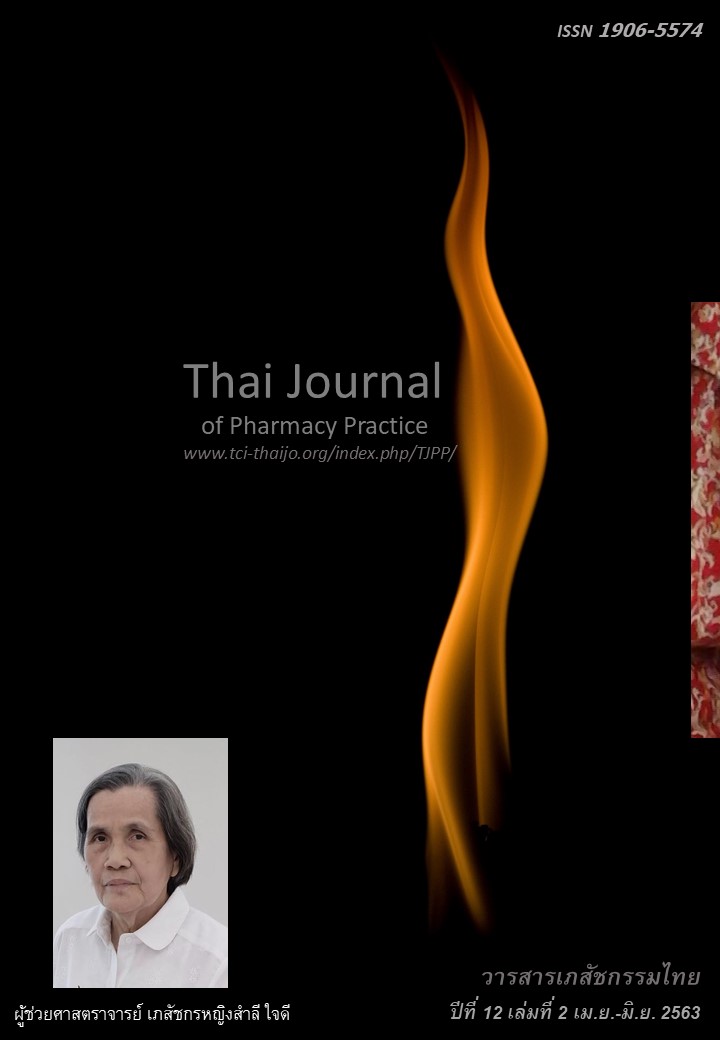การใช้ยาในผู้ป่วยโรคไม่ติดต่อเรื้อรังและผลลัพธ์ทางสุขภาพในโรงพยาบาลหนองหาน จังหวัดอุดรธานี
Main Article Content
บทคัดย่อ
วัตถุประสงค์: 1) วิเคราะห์รูปแบบการใช้ยา แนวโน้มของปริมาณการใช้และค่าใช้จ่ายของยาสำหรับโรคไม่ติดต่อเรื้อรังในโรงพยาบาลหนองหาน 2) หาปัจจัยที่สัมพันธ์กับปริมาณการใช้ยาและค่าใช้จ่ายด้านยา และ 3) วิเคราะห์แนวโน้มของผลลัพธ์ทางสุขภาพ ได้แก่ การควบคุมความผิดปกติของระดับน้ำตาล ความดันโลหิต และการกลับเข้านอนโรงพยาบาลในผู้ป่วยที่ได้รับยาดังกล่าว วิธีการ: การวิจัยนี้เป็นการศึกษาแบบย้อนหลัง โดยใช้ข้อมูลอิเล็กทรอนิกส์ ได้แก่ ข้อมูลการใช้บริการผู้ป่วยนอก ข้อมูลการใช้บริการผู้ป่วยใน และข้อมูลการสั่งจ่ายยาผู้ป่วยนอกของโรงพยาบาลหนองหานในผู้ป่วยที่ได้รับการสั่งใช้ยาสำหรับ 5 กลุ่มโรค (โรคที่สามารถป้องกันหรือลดการมานอนโรงพยาบาลได้ด้วยการดูแลรักษาแบบผู้ป่วยนอก) ตามรหัสการจำแนกแบบ Anatomical, Therapeutic, Chemical (ATC) ขององค์การอนามัยโลก ประกอบด้วย ยารักษาเบาหวาน (A10) ยาลดความดันโลหิต (C02, C03, C07, C08 และ C09) ยากันชัก (N03) ยารักษาโรคหืด (R03A, R03BA, R03C) และยารักษาปอดอุดกั้นเรื้อรัง (R03BB) ในปีงบประมาณ 2558 – 2561 การวิเคราะห์ข้อมูลใช้การวิเคราะห์อนุกรมเวลา สำหรับการหาแนวโน้ม และวิเคราะห์ถดถอยเชิงเส้นตรงสำหรับการหาความสัมพันธ์ของปัจจัย ผลการวิจัย: ผู้ป่วยได้รับยาสำหรับโรคไม่ติดต่อเรื้อรัง โดยเฉลี่ยต่อใบสั่งคิดเป็น 6.14, 5.96, 5.56 และ 5.60 ขนาน ในปี 2558, 2559, 2560 และ 2561 ตามลำดับ ซึ่งเป็นแนวโน้มที่ลดลงอย่างมีนัยสำคัญทางสถิติ (P<0.001) สัดส่วนใบสั่งยาที่มียามากกว่า 5 ขนานมีแนวโน้มลดลงในช่วงเวลาดังกล่าว คือ ร้อยละ 15.59, 14.05, 14.08 และ 13.60 ตามลำดับ แต่ไม่มีนัยสำคัญทางสถิติ (p >0.05) อย่างไรก็ตาม ปริมาณการใช้ยาโดยรวมของกลุ่มผู้ป่วยที่ได้รับยาสำหรับโรคไม่ติดต่อเรื้อรังมีแนวโน้มเพิ่มขึ้นอย่างมีนัยสำคัญทางสถิติ (P<0.05) โดยเฉลี่ยปีละ 57 defined-daily doses (DDDs) เมื่อพิจารณารายกลุ่มยาพบว่า ยาลดความดันโลหิตสูงมีปริมาณการใช้ยาสูงสุดในปี 2561 คือ 474 DDDs โดยมีอัตราการเติบโตโดยเฉลี่ยต่อปีที่ 70 DDDs รองลงมาคือยารักษาเบาหวานมีอัตราการเติบโตต่อปี 58 DDDs สำหรับค่าใช้จ่ายด้านยากลุ่มผู้ป่วยที่ได้รับยาโรคไม่ติดต่อเรื้อรังโดยรวม มีแนวโน้มเพิ่มขึ้นอย่างมีนัยสำคัญทางสถิติ (P<0.05) โดยมีอัตราการเติบโตโดยเฉลี่ยต่อปี 147 บาทต่อคน โดยกลุ่มผู้ได้รับยากันชักมีอัตราการเติบโตของค่าใช้จ่ายสูงที่สุดเฉลี่ยต่อปี 223 บาทต่อคนต่อปี รองลงมาคือกลุ่มผู้ได้รับยาเบาหวาน ผู้ได้รับยารักษาโรคหืดและปอดอุดกั้นเรื้อรัง และผู้ได้รับยาลดความดันโลหิตสูง มีอัตราการเติบโตของค่าใช้จ่ายที่ 218 148 และ 127 บาทต่อคนต่อปี ตามลำดับ ปัจจัยที่มีความสัมพันธ์กับการเพิ่มขึ้นของปริมาณและค่าใช้จ่ายด้านยามากที่สุดคือ การได้รับยาสำหรับโรคไม่ติดต่อเรื้อรัง รองลงมาคือ วัยสูงอายุ 60 ปีขึ้นไป ในด้านผลลัพธ์ทางสุขภาพ พบว่า การควบคุมระดับความดันโลหิตได้ในผู้ที่ได้รับยาความดันโลหิตสูงมีสัดส่วนเพิ่มขึ้น ในขณะที่การควบคุมระดับน้ำตาลได้ในผู้ที่ได้รับยารักษาเบาหวานมีสัดส่วนลดลง นอกจากนี้ การกลับเข้านอนโรงพยาบาลภายใน 28 วันมีสัดส่วนเพิ่มขึ้นในผู้ป่วยที่ได้รับการสั่งใช้ยารักษาเบาหวานและปอดอุดกันเรื้อรัง แต่มีสัดส่วนลดลงในผู้ป่วยที่ได้รับการสั่งใช้ยาลดความดันโลหิต สรุป: ปริมาณการใช้ยาโดยรวมมีแนวโน้มสูงขึ้น ส่งผลให้ค่าใช้จ่ายด้านยาของโรงพยาบาลเพิ่มขึ้น ในขณะที่ผลลัพธ์ทางสุขภาพของผู้ป่วยที่ได้รับการสั่งใช้ยารักษาเบาหวานยังมีแนวโน้มที่ควบคุมได้ไม่ดีนัก
Article Details
ผลการวิจัยและความคิดเห็นที่ปรากฏในบทความถือเป็นความคิดเห็นและอยู่ในความรับผิดชอบของผู้นิพนธ์ มิใช่ความเห็นหรือความรับผิดชอบของกองบรรณาธิการ หรือคณะเภสัชศาสตร์ มหาวิทยาลัยสงขลานครินทร์ ทั้งนี้ไม่รวมความผิดพลาดอันเกิดจากการพิมพ์ บทความที่ได้รับการเผยแพร่โดยวารสารเภสัชกรรมไทยถือเป็นสิทธิ์ของวารสารฯ
เอกสารอ้างอิง
2. National Health Security Office. Universal Health care Scheme (UCS). [online] 2018 [cited Oct 15, 2018]. Available from: uckkpho.com/index.php/download/fin ish/1-/630-2562/0
3. National Health Security Office. Quality and outcomes framework (QOF). [online] 2018 [cited Oct 15, 2018]. Available from: bkk.nhso.go.th/fy61starter/manual4. pdf
4. Limwattananon S. Age-standardized hospitalization with ambulatory care sensitive conditions (ACSC). Nonthaburi. Health Insurance System Research Office; 2011: p. 7-8.
5. World Health Organization [WHO]. Definition and general considerations DDD. [online] 2018 [cited Dec 15, 2018]. Available from: www.whocc.no/ddd/ definition_and_general_considera/
6. World Health Organization [WHO]. How to investigate drug use in health facilities: Selected drug use indicators [online] 1993 [cited 2018, Sep 11]. Available from: apps.who.int/medicinedocs/en/d/Js2 289e/
7. Chiewchantanakit D. Medication use situation and the development of quality indicator in medication use for elderly in Thailand [doctoral thesis]. Bangkok: Chulalongkorn University; 2013.
8. Jainaf NRAM, Parimalakrishnan S, Ramakrishna RM. Study on drug utilization pattern of antihypertensive medications on out-patients and inpatients in a tertiary care teaching hospital: A cross sectional study. Afr J Pharm Pharmacol 2015; 9: 383–96.
9.Øymoen A, Pottegård A, Almarsdóttir AB. Character- istics and drug utilization patterns for heavy users of prescription drugs among the elderly: A Danish register-based drug utilization study. Eur J Clin Phar macol 2015; 71: 751–8.
10. Dilokthornsakul P, Chaiyakunapruk N, Nimpitakpong P. Effects of direct billing system on prescribing patterns in the civil servant medical benefit scheme. Journal of Health Systems Research 2010; 4: 53-62.
11. Saastamoinen LK, Verho J. Register-based indica tors for potentially inappropriate medication in high-cost patients with excessive polypharmacy. Pharma coepidemiol Drug Saf 2015; 24: 610–8.
12. Lee JT, Hamid F, Pati S, Atun R, Millett C. Impact of noncommunicable disease multimorbidity on healthcare utilisation and out-of-pocket expenditures in middle-income countries: Cross sectional analysis . PLoS ONE 2015; 10: e0127199.
13. Siriwattanamethanon Y, Topark-Ngarm A. compa rison of glycemic control in type 2 diabetic patients between two treatment goals. Srinagarind Medical Journal 2018; 33: 511-19.
14. Bachhav SS, Kshirsagar NA. Systematic review of drug utilization studies & the use of the drug classification system in the WHO-SEARO Region. Indian J Med Res 2015; 142: 120.
15. Huang LY, Shau WY, Chen HC, Su S, Yang MC, Yeh HL, et al. Pattern analysis and variations in the utilization of antihypertensive drugs in Taiwan: A six-year study. Eur Rev Med Pharmacol Sci 2013; 17: 410–9.
16. Salvi F, Rossi L, Lattanzio F, Cherubini A. Is polypharmacy an independent risk factor for adverse outcomes after an emergency department visit? Intern Emerg Med 2017; 12: 213–20.
17. World Health Organization [WHO]. Promoting rational use of medicines: core components [online] 2002 [cited Sep 11, 2018]. Available from: apps.who.int/ medicinedocs/pdf/h3011e/h3011e.pdf


